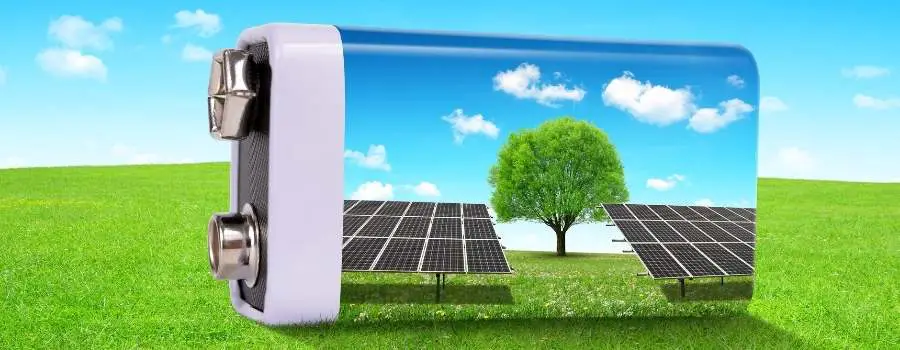The best way to add value to a solar power system is to invest in solar batteries. However, any battery has a limited lifespan before they stop performing well. That’s true for solar batteries as well.
In general, solar battery last between 5 and 15 years. Lifespan depends on battery type and quality. Additionally, how you use, store, and maintain your solar battery will affect its lifespan. When a solar battery reaches the end of its life, it’ll lose its ability to hold an electrical charge.
This guide will teach you everything you need to know about solar batteries. First, you’ll learn how long you can expect a standard solar battery to last. Then, you’ll discover the factors that affect that lifespan and what you can do to maximize it.

What Is The Life Expectancy Of A Solar Battery?
When you invest in a solar battery, you can expect it to last anywhere between 5 and 15 years.
With that expected lifespan of 5 to 15 years, there’s a strong likelihood you’ll have to replace the battery at least once. That’s because a solar power system has an overall lifespan of 20 to 30 years in total, and even the best batteries only last half as long.
So, when you put together your solar power system, you should plan ahead to replace the batteries at least one time in the future.
In the meantime, don’t worry too much about the battery! Your solar power system will continue to function even when your battery starts to get a little too old.
That’s because solar batteries don’t just stop working entirely at the end of their lifespan. Instead, they gradually lose their ability to hold an electrical charge the older they get.
Or in other words, a solar battery at the end of its useful lifespan won’t store as much power as it did when it was still new.
What Determines The Lifespan Of A Solar Battery?

A life expectancy of 5 to 15 years is a pretty broad range for solar batteries. That’s because several factors will determine how long your solar battery lasts. They include the battery type, how you use it, and whether or not you take good care of it.
Here are 5 factors that determine the lifespan of a solar battery:
1. Solar Battery Type
Solar batteries come in several different types. Each one uses different chemistry to store and discharge electricity as a part of your solar power system. The 3 most common solar battery types include:
- Lead-Acid Batteries: This type of solar battery has been used for decades. They’re a popular choice for many solar power systems because they’re the most affordable battery option. Unfortunately, the tradeoff is that they also have the shortest lifespan.
- Lithium-Ion Batteries: These solar batteries are the top-of-the-line option for solar power systems. They have a longer lifespan, but they also have other positive qualities like being lightweight and smaller in size. Also known as “Li-ion” batteries, these ones cost more than lead-acid for the added value they offer.
- Nickel-Cadmium: These batteries aren’t as popular as lead-acid or lithium-ion ones. That’s most likely because these batteries are suited for large-scale uses, like by utility companies generating solar power. You won’t find these being used in a household solar power system. Still, these batteries are incredibly durable even in extreme temperatures and have an exceptional lifespan.
2. Usage Patterns
The well-being of a solar battery is also affected by how much or how little you use it.
Firstly, all solar batteries go through charge and discharge cycles. So, the more often you use and recharge the battery, the shorter its lifespan will be.
However, the opposite also causes the same outcome. For example, let’s suppose you keep your solar battery on a shelf in your garage and never use it. That battery will still self-discharge continuously, eventually draining the power stored inside.
The longer you let that go on without recharging the battery, the sooner it’ll wear out.
So, that famous saying “use it or lose it” certainly applies to these batteries.
3. Operating Temperature
Each solar battery has an optimal operating temperature. The manufacturer will let you know the optimal temperature by printing it somewhere in the owner’s manual.
That optimal temperature not only ensures that the battery can perform well (i.e. store and supply electricity as it should). But, it also maximizes the battery’s useful lifespan.
Because of that, you’ll have to be more mindful of where you install your solar battery. The battery will do well outdoors if your local climate is stable or indoors (in a basement or garage) if outside temperatures are extreme.
4. Maintenance And Care
Like every other part of your solar power system, your battery will also require regular care and maintenance. So, neglecting it after making it a part of your solar power system will cause it to wear out faster than usual.
However, following the manufacturer’s care instructions regularly will help keep that battery working longer.
5. Warranty
Lastly, the manufacturer’s warranty is also an essential factor. That warranty represents the manufacturer’s confidence in how long their product will last. It also indicates the level of build and material quality that went into that battery, giving you peace of mind that it’ll last as long as it should.
After all, if the battery doesn’t last as long as it should, the warranty keeps you from paying for a brand new battery unnecessarily.

What Can Damage A Solar Battery?
Several things can damage your solar battery and shorten its lifespan. They include:
- Electrolyte Loss: Lead-acid solar batteries must have the correct fluid levels to function correctly. That fluid consists of sulfuric acid and water. The water will evaporate as you continue using the battery, requiring you to top it up with more. If you fail to do that regularly, that leads to electrolyte loss that shortens the battery’s lifespan.
- Electrolyte Stratification: Besides electrolyte loss, stratification is another problem. The sulfuric acid and water should be well-mixed. But if you don’t charge the battery fully, the two substances can separate. That’s called stratification, and it will reduce the battery’s performance.
- Overly Deep Discharge: Solar batteries are known as deep-cycle batteries. That means you can safely discharge a significant portion of its stored power before recharging it. However, discharging too much of that power without recharging will cause the battery to wear out faster. Typically, using the battery for several days without sunlight to recharge will cause this problem.
- Sulfation: Solar batteries function thanks to the chemistry that goes on inside each unit. Under ordinary uses, chemistry temporarily produces lead sulfate crystals that stick to some internal parts. Those crystals typically disappear whenever you recharge the battery. However, irregular charging will cause those crystals to harden permanently, reducing the battery’s performance and shortening its lifespan.
As you can see, it’s not enough to set up your solar battery and hope for the best. There are also proper steps to take when charging, maintaining, and using each battery to ensure it lasts as long as possible. Always refer to the user manual for the best results and follow the manufacturer’s advice.
How Can I Make My Solar Battery Last Longer?
All solar batteries have a limited lifespan. Sooner or later, everyone has to replace the solar batteries they use. Despite that, you can maximize your battery’s lifespan by keeping them charged and doing so correctly. Plus, it helps to use large battery interconnect cables, limit how many batteries you use together, and rotate them regularly.
Let’s take a closer look at each of those 5 steps:
- Keep Batteries Charged: Firstly, you must always keep your solar batteries charged. That’s especially true if you’re not using the battery, like if you’re keeping it on a shelf for emergencies. Remember: “Use it or lose it” applies here.
- Charge Batteries Correctly: Secondly, always ensure that your solar batteries are charged correctly. Overcharging and undercharging are both equally harmful to your battery. You can disconnect the battery when it’s fully charged or invest in a charge controller.
- Use Large Interconnect Cables: You’ll need cables to connect your solar battery to the rest of the solar power system. Larger cables produce less electrical resistance, and that’ll help reduce wear on your solar battery.
- Limit Number Of Batteries: Solar batteries are often used together to form a battery array. Still, using fewer batteries together will maximize their lifespan. That’s because fewer batteries mean less resistance and wear.
- Rotate Batteries Regularly: If you are using several batteries together, rotate their arrangement in the battery array. For example, the first battery might charge better than the last one. Rotating ensures that they experience the same wear and tear over an extended period.
Is It Worth Getting A Battery With Solar?
Generally, investing in a solar battery is worth the price you pay. Firstly, using a battery with your solar system allows you to capture and store power for when there’s no sunlight, like at night.
On top of that, comparing the average battery lifespan (5-15 years) and overall solar system lifespan (20-30 years), you’ll likely only have to replace the battery one time.
Add to this, pretty much all home solar panel arrays are designed to work with solar batteries. Combining all of those factors, a solar battery is most definitely worth the investment.
